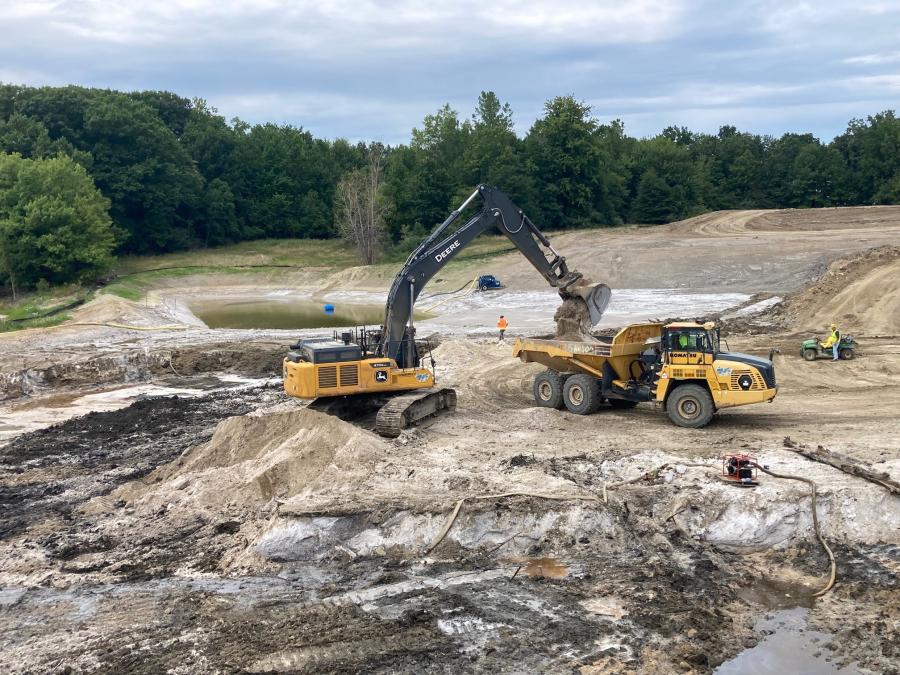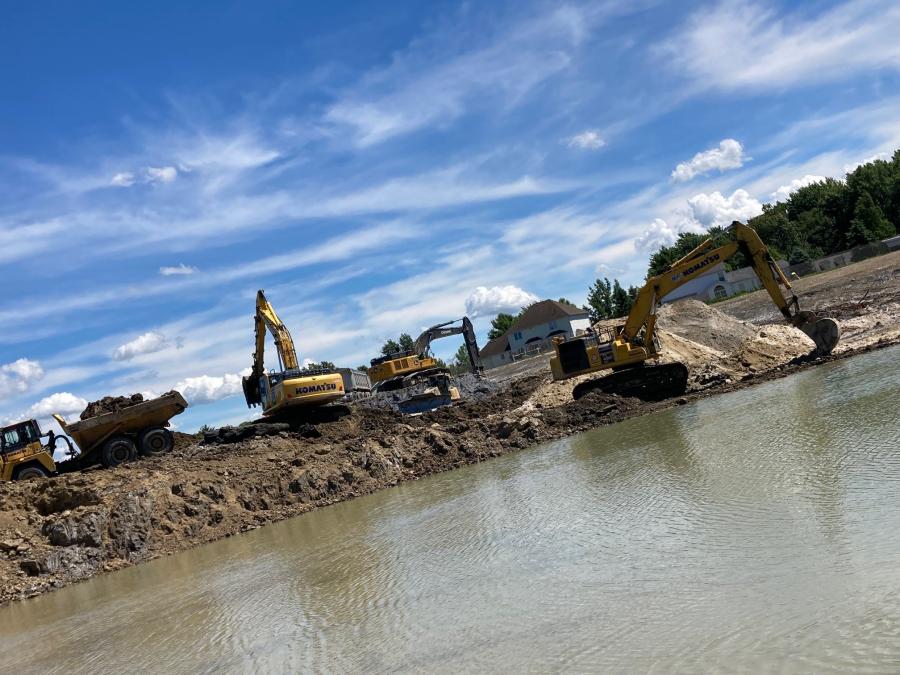Cleanup crews are currently ahead of schedule, and the work is reportedly going well. $10.6 million has been funded through the settlement of a consent order with Osborne Company and the estate of John Osborne.
(The Great Lakes Construction Co. photo)
One of the largest natural marshes remaining along the Lake Erie shoreline is undergoing a dramatic transformation as part of a salt fill remediation project overseen by Ohio's Environmental Protection Agency (EPA). Crews are working to reverse the legacy contamination that has tainted Mentor Marsh for decades.
"Mentor Marsh is an important habitat for animals and is important for water quality and habitat for Lake Erie," said David Emerman, Ohio EPA assistant chief, division of surface water. "Remediation is necessary because of the releases of salt to Blackbrook Creek and Mentor Marsh. This resulted in uncontrolled discharges impacting water quality standards for pH and total dissolved solids to waters of the state."
In the 1960s, salt mining waste by the tons was deposited near the more than 700 acres of forested wetland. Emerman said although residents were opposed to the dumping, the events took place before the creation of both the United States' EPA and Ohio EPA, and prior to the Clean Water Act. The property has been a source of chlorides that have severely affected the marsh and caused water quality issues.
"This has been harmful to this wetland, which feeds into Lake Erie. Removing the salt and remediating the marsh will have a tremendously positive impact on the environment."
According to Emerman, within one year, all trees in Mentor Marsh died and were replaced with invasive phragmites. Often, these plants caused fires, one of which burned 500 acres of the marshland.
"Ohio EPA has worked with landowners and the community over the years on remediation attempts, including rerouting Blackbrook Creek. None of these prior attempts have been successful. Past litigation also was a factor in the length of time to complete remediation attempts."
Cleanup crews are currently ahead of schedule, and the work is reportedly going well. Emerman noted that $10.6 million has been funded through the settlement of a consent order with Osborne Company and the estate of John Osborne.
"This project is a result of work by Ohio EPA, the city of Mentor, Ohio Department of Natural Resources, the Cleveland Museum of Natural History, Lake County Soil and Water Conservation District, Lake County Land Bank and many others, with support from residents and community members.
"There has been a lot of outreach, including community information sessions. Residents are largely pleased to see this project going forward. Many had seen the fires that occurred, and now are seeing these hazards removed. Residents can see the value and how this will enhance the natural environment."
The Great Lakes Construction Co. serves as the environmental contractor for the long-awaited remediation. Great Lakes project manager Jeremy Levenson said the elements have been a major concern for workers.
"The largest challenge on this project is dealing with the weather, because it can significantly hinder our ability to run trucks onsite, affecting our productivity and our schedule. We need to keep a close eye on the forecast so that, during poor conditions, we can stay productive on other items, such as onsite hauling and stormwater management.
"As with most major earth moving projects, the weather can have a significant impact on the schedule. One day of steady rain can cost two or three days of productivity."
Prep work started in May, with excavation beginning in late June. Levenson explained that disposing of waste salt is a detailed process.
"First, the natural dirt is removed from the top to expose the salt. Then, large excavators load the salt into dump trucks. The key to moving large quantities is to always have the large excavators working, and the trucks moving. This again stresses the importance of keeping a smooth flow to the truck traffic. Any time they are waiting for trucks reduces the amount of salt that gets hauled out that day.
"All the Great Lakes Construction Co. crews start every day performing a pre-task analysis, where they discuss the day's operations and address all potential safety concerns, and the protection of the environment and the residents. On a large remediation project like this, each day of the project is very similar to the last. They start loading out the waste material from the leading edge of the excavation into the trucks. Bulldozers and smaller excavators assist with pushing more salt within reach of the larger excavators that are loading trucks, so that the larger excavators can stay productive."
There are typically 30 to 40 dump trucks on the project each day crews are hauling waste offsite. The trucking route is kept the same, and the vehicles are spread out as evenly as possible.
By the end of the project, workers will have spent several months loading and hauling the waste material offsite.
As far as handling the material, said Levenson, "Salt and fly ash are not regulated materials; however, all of our tradespeople are properly trained through Great Lakes Operating Standards System [GLOSS], Great Lakes' online university, micro-learnings and safety talks.
"We anticipate approximately 120,000 to 160,000 tons of salt and fly ash to be hauled off site. All clean materials, such as clay and topsoil, are being reused onsite. The waste material is being hauled to the Geneva Landfill.
The affected area is adjacent to a residential subdivision, a situation that also must be addressed.
"The EPA and the contractor have maintained open communication with the residents and made ourselves available to answer their questions. Because of the proximity of the project to the homes, we pay extra attention to mitigating fugitive dust, and we minimize construction noise during extended hours."
The ongoing work also has included constructing a truck access road.
"During the preconstruction phase, we obtained a permit from the Ohio Department of Transportation to establish construction access to SR 44. In addition to maintaining compliance with the permit, we must keep the site secured. And upon completion of the project, the ODOT right-of-way must be restored to its original condition."
Once waste removal is finished, the site will be graded, and the topsoil respread. The site will then be stabilized with a native grass.
Primary equipment on the project consists of a John Deere 750K LGP dozer; a Komatsu D85EXI dozer; Komatsu MH300 off-road articulating dump trucks; a Komatsu PC360 excavator; a John Deere 470 excavator; a Komatsu WA380-6 articulating front-end loader; and a Caterpillar 140G grader.
Substantial completion is expected by the end of October 2022, with a goal of transferring the land to the Cleveland Museum of Natural History. Levenson said it's truly rewarding to play such a key role in the cleanup.
"This is a very prominent project in northeast Ohio, and a drastic improvement to our environment. As such, we are proud to be involved, to be able to make a difference. Some of our crewmembers are from this area and can reflect on it for years to come." CEG
Cindy Riley
Birmingham, Ala., native Cindy RIley originally planned on a career in law, but during her sophomore year in college realized journalism was her true calling. A magna cum laude graduate of Samford University, Riley first worked in radio and TV. Named Best News Anchor, Best News Reporter and Best Investigative Reporter by the Associated Press, she interviewed numerous personalities, ranging from Dr. Henry Kissinger and President Bush to Michael Jordan and Captain Kangaroo.
As a print journalist, Riley has covered a variety of topics, including construction, business, health and the arts. In addition to CEG, her work has appeared in special reports for USA Today and the L.A. Times. Other publications have included New South Magazine, Portico, Thicket, Alabama Heritage, B-Metro, Business First and Birmingham Business Journal.
Read more from Cindy Riley here.
Today's top stories






















